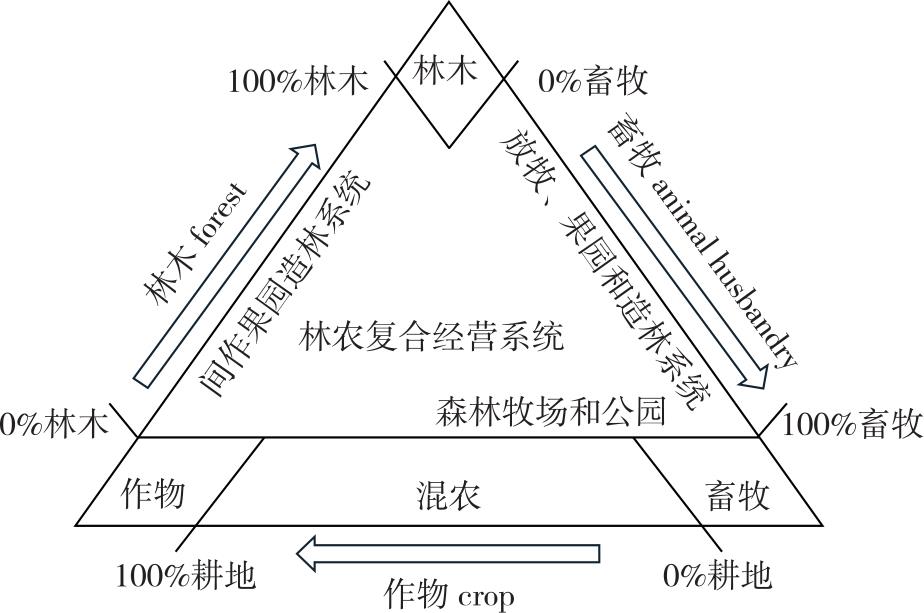 PDF(1467 KB)
PDF(1467 KB)


Constructing mechanisms and induction of empirical models for agroforestry compound management
DONG Bo
Journal of Nanjing Forestry University (Natural Sciences Edition) ›› 2025, Vol. 49 ›› Issue (3) : 245-253.
 PDF(1467 KB)
PDF(1467 KB)
 PDF(1467 KB)
PDF(1467 KB)
Constructing mechanisms and induction of empirical models for agroforestry compound management
【Objective】Agroforestry compound management is widely acknowledged as a promising strategy for guaranteeing the sustainability of future agricultural production. This research is dedicated to exploring and optimizing the agroforestry management system with Chinese characteristics. By elucidating its complex mechanisms and summarizing empirical models, the study aims to maintain the sustainable production of both forestry and agriculture in the future. 【Method】Based on an all-round review of agroforestry management practices, this paper focuses on constructing the agroforestry management mechanism to identify the roles of various factors. It also aims to summarize experience-based models suitable for different environmental conditions. Specifically, a detailed analysis of biophysical factors, socio-economic factors, farmers’ endowments, production enterprises, and safeguard measures has been carried out. 【Result】(1) The agroforestry management mechanism is significantly influenced by multiple factors. These encompass biophysical conditions such as soil quality, climate, and topography; socio-economic factors like market demand, economic policies, and the rural labor force; farmers’ endowments in terms of land resources, farming skills, and financial capabilities; production enterprises with their production scale, technological innovation, and market-orientation; and safeguard measures including agricultural policies, forest protection regulations, and rural infrastructure construction. (2) According to the degree of utilization of ecosystem types, agroforestry management systems can be classified into four main categories: agroforestry systems, mainly centering on the combination of agricultural crops and forest trees; forest-pastoral systems, emphasizing the integration of forestry and livestock grazing; agroforestry-pastoral systems, integrating agriculture, forestry, and animal husbandry; and other special systems customized to specific local ecological and socio-economic conditions. (3) In Europe and the Americas, through the efforts of farms and research institutes, forest-farm-livestock composite management practice systems and scientific research systems have been established respectively. These systems enable the meticulous management of agricultural production, covering aspects such as precise resource allocation, scientific breeding, and the efficient utilization of agricultural land. In contrast, most regions in Asia still primarily rely on traditional agroforestry management systems, which are characterized by relatively simple production models and less advanced technologies. (4) China has a long-standing history of agroforestry management with diverse modes. These modes show obvious spatial differentiation due to differences in the natural environment, economic development level, and cultural traditions in different regions. However, there is still a gap between the technological application in China’s agroforestry management and the international advanced level, especially in areas such as modern agricultural machinery, information technology, and ecological management. 【Conclusion】In light of the above-mentioned findings, it is of great significance to promote the sustainable development of China’s agroforestry management system. This can be achieved by establishing an agroforestry management mechanism tailored to local conditions, actively enhancing farmers’ production concepts and technical capabilities through training and extension services, and constructing a comprehensive risk-defense mechanism and a sound policy-guarantee system. The risk-defense mechanism should cover aspects such as natural disaster prevention, market risk mitigation, and technological innovation risks, while the policy-guarantee system should include preferential policies for agroforestry development, financial support, and land-use policies.

agroforestry management / driving mechanisms / management models / precision agriculture / rural revitalization
| [1] |
|
| [2] |
IPCC. Global warming of 1.5 ℃[M]. Cambridge, UK: Cambridge University Press, 2022.DOI:10.1017/9781009157940.
|
| [3] |
|
| [4] |
|
| [5] |
|
| [6] |
CIPC. Climate change 2014:mitigation of climate change[M]. Cambridge, UK: Cambridge University Press, 2015.DOI:10.1017/cbo9781107415416.
|
| [7] |
|
| [8] |
|
| [9] |
况小宝, 张本俊, 史志华. 农林复合经营系统研究现状[J]. 江西林业科技, 2003, 31(2):29-31.
|
| [10] |
熊文愈, 薛建辉. 混农林业:一条发展林业的有效途径[J]. 世界林业研究, 1991, 4(2):27-31.
|
| [11] |
赵恺, 岳永杰, 李旭, 等. 科尔沁沙地林农复合经营综合效益评价[J]. 林业调查规划, 2022, 47(5):146-151.
|
| [12] |
冯渊圆, 胡海波, 祝文斌, 等. 苏北沿海林农复合经营系统环境特征及农作物光合特性[J]. 江苏农业学报, 2019, 35(1):96-102.
|
| [13] |
周玉新, 周健芝, 戴迎春. 基于Probit-ISM模型的农户林农复合经营行为影响因素分析[J]. 中国农学通报, 2018, 34(30):153-159.
|
| [14] |
朱玲, 周玉新, 唐罗忠, 等. 我国林农复合经营模式及其综合评价方法[J]. 南京林业大学学报(自然科学版), 2015, 39(4):149-156.
|
| [15] |
|
| [16] |
|
| [17] |
李昌晓, 李昌阳, 汤兴华. 几种典型混农林业模式的综合评价[J]. 西南师范大学学报(自然科学版), 2003, 28(2):288-293.
|
| [18] |
童婷婷, 周玉新, 唐罗忠. 林农复合经营经济效益评价研究现状与展望[J]. 世界林业研究, 2013, 26(5):13-18.
|
| [19] |
刘俊杰, 张晖, 陈思焜. 农户参与林农复合经营的影响因素分析:以黄淮海地区江苏丰县为例[J]. 江苏农业科学, 2014, 42(10):410-412.
|
| [20] |
李勇美, 张金池, 郭小平, 等. 不同林农复合经营模式对作物生长和产量的影响[J]. 西北农林科技大学学报(自然科学版), 2013, 41(2):61-68.
|
| [21] |
杨灿, 李建军, 黄静, 等. 洞庭湖洲滩人工林林农复合经营模式与综合效益研究[J]. 中南林业科技大学学报, 2017, 37(5):106-112.
|
| [22] |
谢京湘, 于汝元, 胡涌. 农林复合生态系统研究概述[J]. 北京林业大学学报, 1988, 10(1):104-108.
|
| [23] |
娄安如. 生物多样性与我国的农林业复合经营[J]. 生态农业研究, 1994, 2(4):14-17.
|
/
| 〈 |
|
〉 |